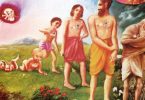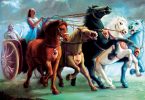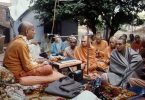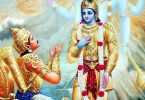Q. 1. I’m confused on the subject of yuga avatars in this cycle of Kali. Gaudiya Vaisnavas claim Sri Caitanya Mahaprabhu as the avatar for this particular cycle of Kali yuga. Since he has already appeared, will this kali yuga end without the appearance of the Kalki avatar? This seems to contradict the Vishnu Purana.
Also, it is cited in Caitanya Caritamrita (Madhya 6.99) that there is no lila avatar in this age of kali, but it does acknowledge Mahaprabhu as an avatara in this cycle, although hidden. This seems to contradict the Vishnu Purana and the Bhagavata Purana as well. The word hidden isn’t used, or as far as I can see, implied in the Bhagavatam verse 11.5.32. Is there any Vedic literature outside of the Gaudiya tradition that support these conclusions?
Q. 2. The description of the appearance of Krsna for this age is cited Srimad Bhagavatam 11.5.32. It is also cited in the Vishnu Purana “will be born in the family of Vishnuyas’as, an eminent Brahman of Sambhala village, as Kalki, endowed with the eight superhuman faculties.” Vishnu Purana 4:24.
Can it be argued that the two descriptions are of the Kalki avatar? Gaudiya Vaisnavas point to this verse, particularly the word akrsnam, as proof that this means golden or yellow. But, the appearance of Kalki seems to fit the translation of the word, as well as the other descriptions (particularly weapons) in the 11.5.32 Srimad Bhagavatam verse.
Answer by Romapada Swami: I will answer these questions together as there is some degree of overlap because of the nature of the topic.
Lord Caitanya is the avatar for Kali Yuga and Kalki avatar will come at the juncture of the 2 yugas – Kali Yuga and Satya Yuga. There are a number of scriptural predictions about appearance of Kalki avatar and Lord Caitanya and they are very distinct and don’t contradict each other.
Though the word hidden is not directly used in the Srimad Bhagavatam verse, there are a number of other indications from Vedic scriptures indicating that His appearance is hidden. Please read the detailed quotes found in the following file: Kalki_ChaitanyaMahaprabhu.pdf
The Srimad Bhagavatam verse 11.5.32 definitely indicates Lord Caitanya and the Visnu Purana verse indicates Kalki avatar.
You raised a point about other descriptions particularly weapons – In the purport to the SB 11.5.32 verse, Srila Jiva Goswami indicates the meaning of Sangopangastra-parsadam. Everything else in the verse indicates that it is referring to Lord Caitanya, especially sankirtana-prayaih which is not a described activity of Lord Kalki in the scriptures.
“Sangopangastra-parsadam further indicates that Lord Caitanya is Lord Krsna. His body is always decorated with ornaments of sandalwood and with sandalwood paste. By His superexcellent beauty He subdues all the people of the age.”
In other descents the Lord sometimes used weapons to defeat the demoniac, but in this age the Lord subdues them with His all-attractive figure as Caitanya Mahaprabhu. Srila Jiva Gosvami explains that His beauty is His astra, or weapon, to subdue the demons. Because He is all-attractive, it is to be understood that all the demigods lived with Him as His companions. His acts were uncommon and His associates wonderful. When He propagated the sankirtana movement, He attracted many great scholars and acaryas, especially in Bengal and Orissa. Lord Caitanya is always accompanied by His best associates like Lord Nityananda, Advaita, Gadadhara and Srivasa.
Apart from our vedic scriptures, Lord Kalki’s avatar appears to be indicated in the Book of Revelations in the Bible. Please read quoted sections in the following file:






